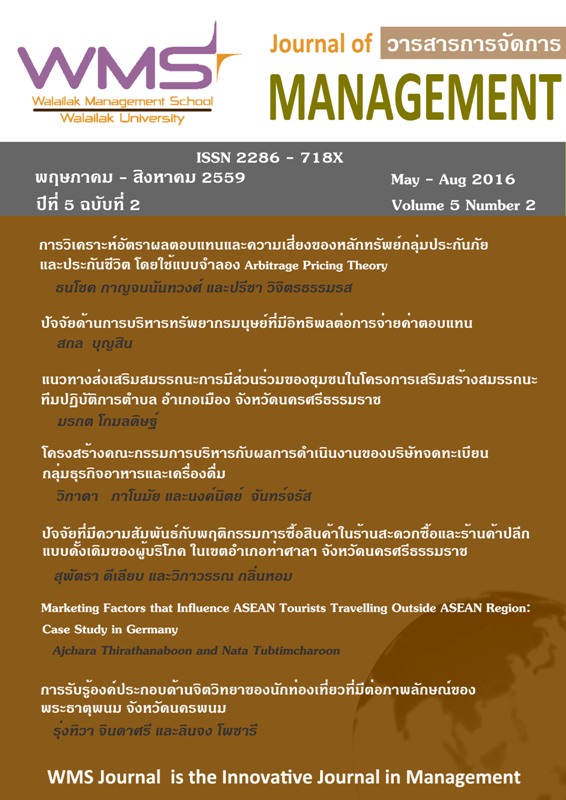Rate of Return and Risk Analysis of the Insurance Securities Using Arbitrage Pricing Theory Model
Main Article Content
Abstract
Article Details
References
ชาติชาย ศิริจันทร์. (2549). การวิเคราะห์ผลตอบแทนและความเสี่ยงของหุ้นการเงินในตลาดหลักทรัพย์แห่งประเทศไทยโดยใช้แบบจำลองเอพีที. การค้นคว้าอิสระ เศรษฐศาสตรมหาบัณฑิต, มหาวิทยาลัยเชียงใหม่.
ปาริชาติ โภชนจันทร์. (2547). การวิเคราะห์การลงทุนในตลาดหลักทรัพย์แห่งประเทศไทยตามทฤษฎีการกำหนดราคาแบบเอพีทีโดยวิธีอินทิเกรชัน. การค้นคว้าอิสระ เศรษฐศาสตรมหาบัณฑิต, มหาวิทยาลัยเชียงใหม่.
พีระ เรืองเกษา. (2540). ผลตอบแทนจากการลงทุนใน หลักทรัพย์กับตัวแปรทางเศรษฐกิจมหภาค. ภาคนิพนธ์ เศรษฐศาสตรมหาบัณฑิต, สถาบันบัณฑิตพัฒนบริหารศาสตร์.
รุ่งรัตน์ มาบุตร. (2549). การวิเคราะห์อัตราผลตอบแทนของหุ้นในตลาดหลักทรัพย์แห่งประเทศไทย. การค้นคว้าอิสระ เศรษฐศาสตรมหาบัณฑิต, มหาวิทยาลัยเชียงใหม่.
วิรัชอร ศรีทรัพย์. (2548). การวิเคราะห์และเปรียบเทียบความสัมพันธ์ระหว่างอัตราผลตอบแทนและความเสี่ยงตามแบบจำลอง CAPM และ APT. ภาคนิพนธ์เศรษฐศาสตรมหาบัณฑิต, สถาบันบัณฑิตพัฒนบริหารศาสตร์.
สุนทรี กัลชาญพิเศษ. (2539). การตัดสินใจลงทุนใน ตลาดหลักทรัพย์แห่งประเทศไทยโดยใช้ แบบจำลอง Arbitrage Pricing Theory (APT). วิทยานิพนธ์เศรษฐศาสตร มหาบัณฑิต, มหาวิทยาลัยเชียงใหม่.
ศุภสวัสดิ์ คัพภสาลี. (2553). การวิเคราะห์ความเสี่ยงและ ผลตอบแทนของหลักทรัพย์กลุ่มประกันภัยและ ประกันชีวิตในตลาดหลักทรัพย์แห่งประเทศไทย. การค้นคว้าอิสระ เศรษฐศาสตร์มหาบัณฑิต, มหาวิทยาลัยเชียงใหม่.
ศศิโสภา ตั้งบุญชัยเจริญ. (2535). ความสัมพันธ์ระหว่างตัวแปร เศรษฐศาสตร์มหภาคกับผลตอบแทนที่คาดหวัง จากากรลงทุน. ภาคนิพนธ์ เศรษฐศาสตรมหาบัณฑิต, สถาบันบัณฑิตพัฒนบริหารศาสตร์.
Azeez, A.A., & Yonezawa, Y. (2006). Macroeconomic factors and the empirical content of the Arbitrage pricing theory in the Japanese stock market. Japan and the world economy, 18, 568-591.
Chen, N., Roll, R. & Ross, S. A. (1989). Economic forces and the stock market. Journal of business, 59(3), 383-403.
Rjoub, H., Tursoy, T. & Gunsel, N. (2009). The effects of macroeconomic factors on stock returns Istanbul stock market.
Studies in economics and finance, 26(1), 36-45.
Singh, T., Mehta, S. & Varsha, M.S. (2011). Macroeconomic factors and stock return evidence from Taiwan. Journal of economics and international finance, 2(4), 217-227.


